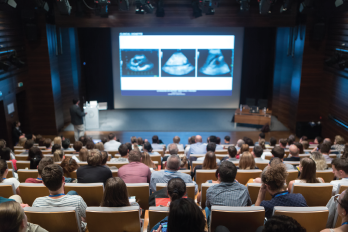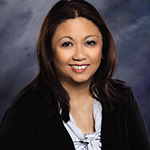
Matej Kastelic / shutterstock.com
ATLANTA—Point-of-care ultrasound education mainly has occurred at the undergraduate level at U.S. medical schools, but rheumatology fellowship training programs are rapidly catching up and integrating it into their curricula, according to two program directors who reviewed the state of rheumatology ultrasound education, including potential barriers to its implementation, on Nov. 12 at the 2019 ACR/ARP Annual Meeting.
From Scarce to Common
Ten years ago, ultrasound training was scarce in rheumatology education, said Karina Torralba, MD, MACM, RhMSUS, rheumatology chief and fellowship program director, Loma Linda University Medical Center, California. Medical students at her institution had little exposure to ultrasound. In 2013, she and her colleague, Vi A. Dinh, MD, an emergency medicine program director, talked about how to integrate ultrasound training into their curricula.
“We agreed that there needed to be a larger volume of faculty involved in this process,” said Dr. Torralba, a member of the ACR Committee on Rheumatology Training and Workforce Issues. “At the time, neurological and musculoskeletal examination via ultrasound was still optional in our programs, but this has slowly evolved.” They now offer yearly instruction in musculoskeletal ultrasound anatomy with both rheumatology and physical medicine and rehabilitation (PM&R) faculty.
Learners benefit from formal ultrasound training, she said, citing a 2015 study that showed first-year medical students improved their physical examination skills, measured by Objective Structured Clinical Examination (OSCE) scores, after they completed ultrasound training.1

Dr. Torralba
The majority of medical school deans agree that ultrasound training should be included in curricula, said Dr. Torralba. According to a 2014 survey of 82 administrators, 62.2% of U.S. medical schools had already integrated point-of-care ultrasound in their training but varied on how to implement it.2 Some programs focused more on anatomy and others on practical physical examination skills training, she said.
Core Clinical Milestones Vary
A 2016 consensus study identified 90 core clinical milestones in ultrasound training that students must obtain before graduation from medical school, according to 34 administrators.3 According to this survey, most medical school-level programs focused on building proficiency in skin, muscle, bond, nerve and tendon ultrasound.
“When we look at musculoskeletal pathology, program directors had a high consensus for looking at foreign bodies and abscesses vs. looking at joint effusions. When it came to ultrasound-guided procedures, their focus was not as much on bone abnormalities and more on emergent conditions. Also, at that time, they had no agreement on arthrocentesis as an ultrasound-guided procedure milestone,” Dr. Torralba said.
When surveyed, medical school directors have cited barriers to ultrasound training, such as lack of funding for equipment and faculty, and lack of time in their current curricula.4 One creative approach is gamification, such as a nationwide skills competition held in 2018 that included students from 34 U.S. medical schools.5 “Students were asked to identify the problem with each case. It was one way to make ultrasound education fun for the learners,” said Dr. Torralba.
Internal medicine residency programs still need to catch up to undergraduate programs when it comes to integrating ultrasound training into their curricula, she said. In 2019, the Alliance for Academic Internal Medicine issued a position statement to support integration of ultrasound across the longitudinal training environment of undergraduate, graduate and continuing medical education for internal medicine.6
In addition to lack of resources for equipment and trained faculty, “there is also no standardized curriculum for our internal medicine residents, and there is a lack of crucial image archival systems and quality assurance,” said Dr. Torralba. Residents do not currently have to exhibit proficiency in a set number of ultrasound procedures to be certified by the Accreditation Council for Graduate Medical Education (ACGME).
Rheumatology Programs
What is the state of musculoskeletal ultrasound training in U.S. rheumatology fellowship programs? According to a 2017 survey Dr. Torralba and her colleagues conducted of 108 rheumatology program directors, 94% had integrated musculoskeletal ultrasound and 41% had a formal ultrasound curriculum.7 While 95% of the respondents favored adoption of formal curricula, 65% said this step could be optional, which was a result of respondents not knowing that the majority of programs have already included ultrasound into their fellowship teaching, she said.
‘Maximize ultrasound training by incorporating & integrating opportunities into your clinical, educational & research programs.’ —Dr. Cannella
If junior rheumatology faculty face resistance from their institutions to integrate musculoskeletal ultrasound in their fellowship programs because other departments already offer this training, they must speak up and advocate for its inclusion, said Dr. Torralba. Eventually, these skills will enhance patient care, and rheumatologists certified in ultrasound should be paid accordingly, she said.
“This makes me really emotional. The ACR has a position statement on musculoskeletal ultrasound from August 2018. It says, ‘Rheumatologists who obtain training and certification in ultrasound should receive fair, timely and reasonable reimbursement for their musculoskeletal ultrasound services.’ Remember that! If you’ve been trained and you’ve been certified, you should be able to bill for your services,” Dr. Torralba said. The rheumatology community should define its own common procedural terminology (CPT) codes for musculoskeletal ultrasound scans that accurately reflect current approaches, because most codes are defined by radiologists.8



